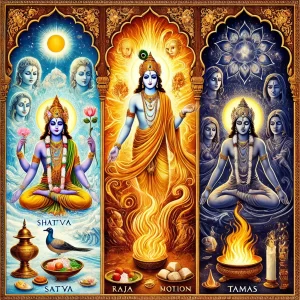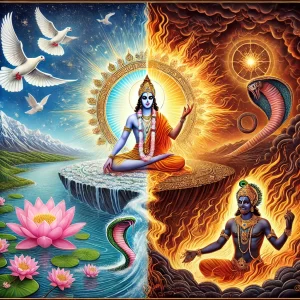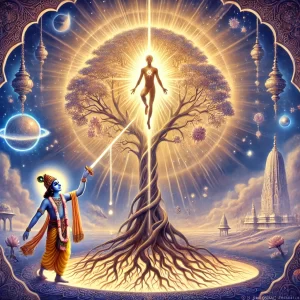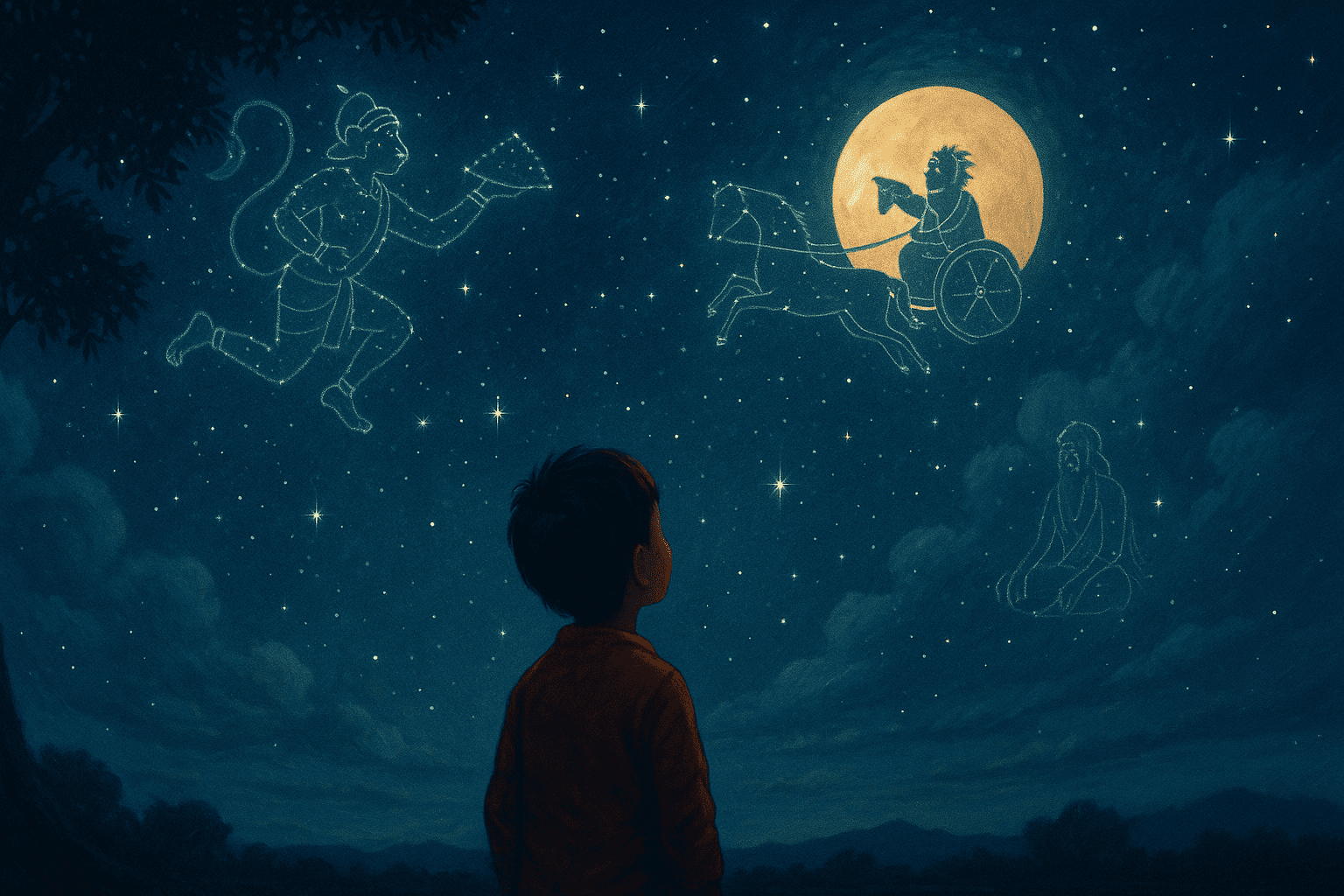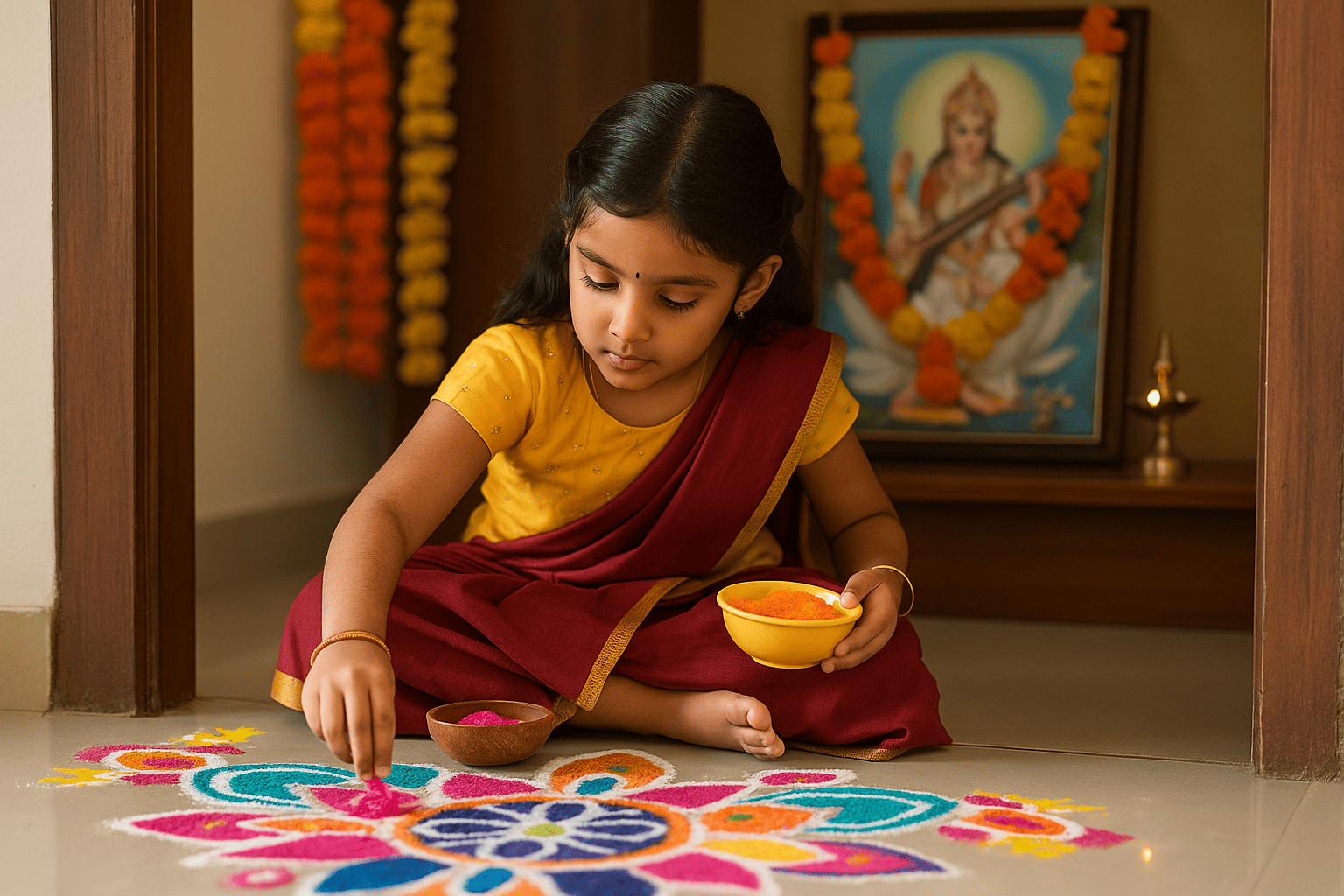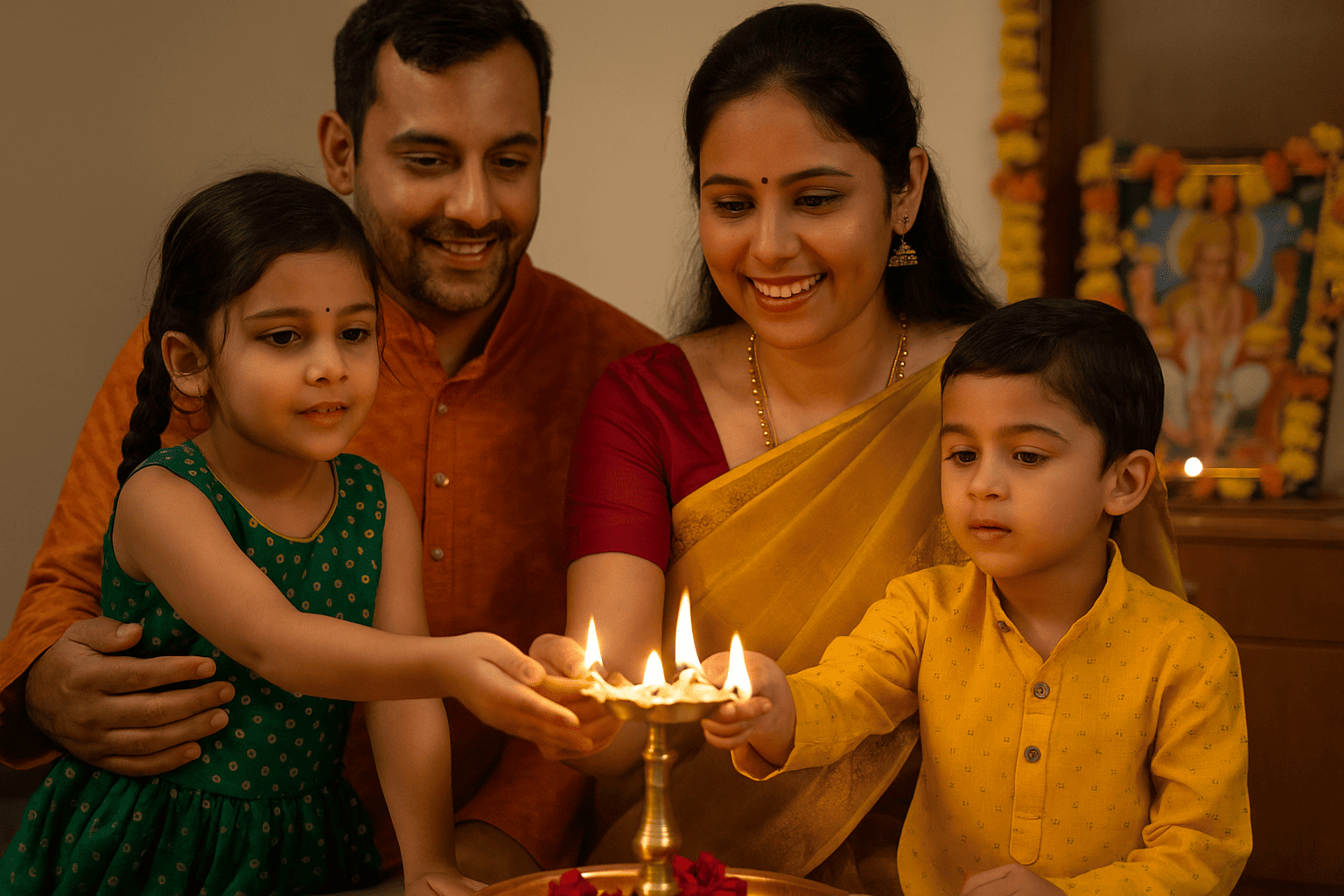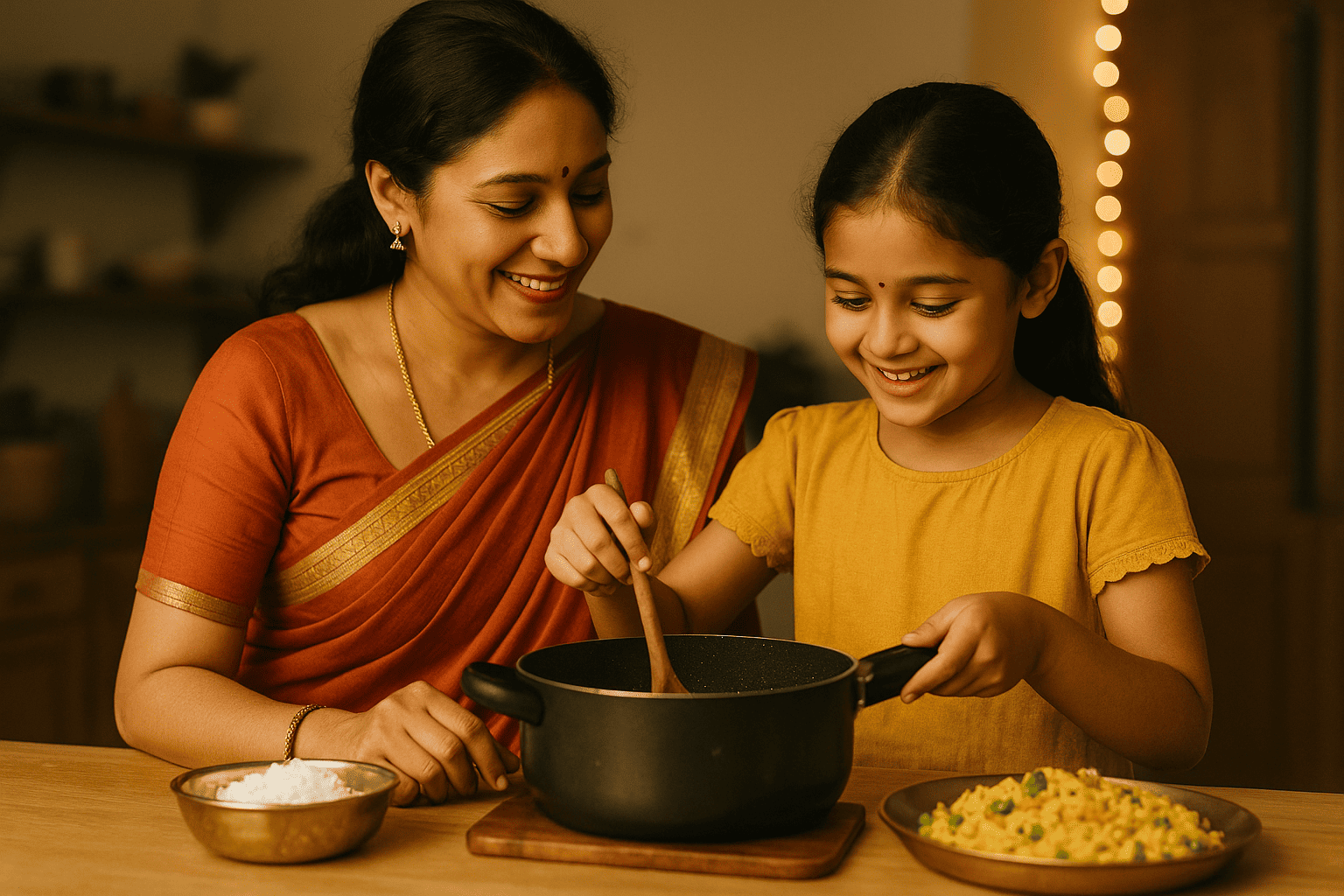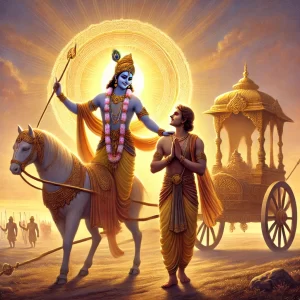
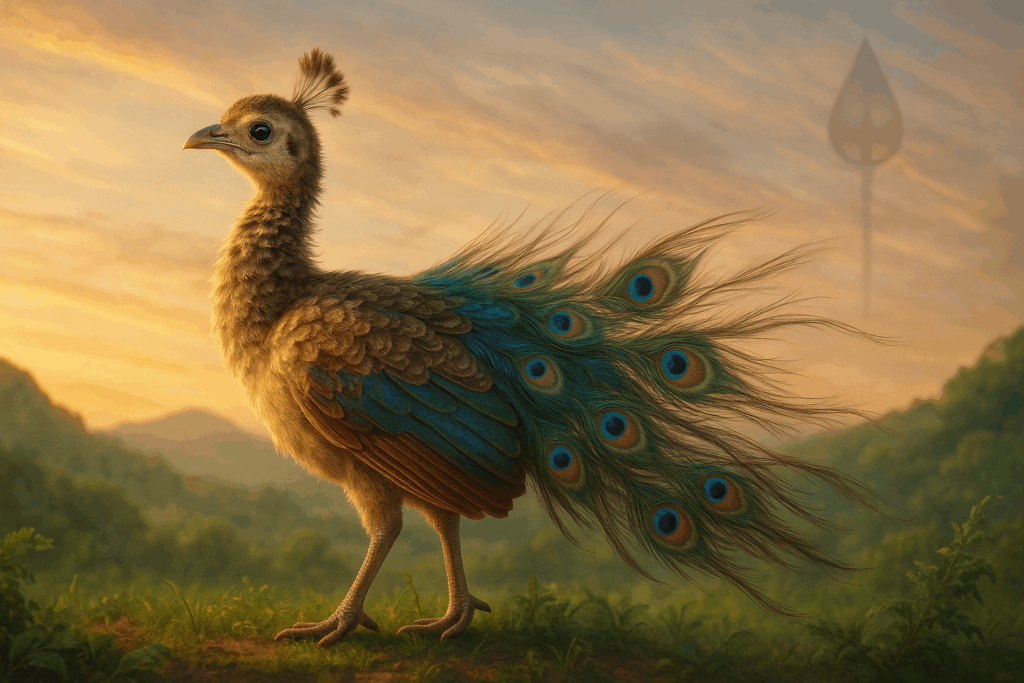
There once was a little peafowl named Mayil, who lived in the golden meadows where the hills touched the sky. She was not quite a chick anymore, but not yet the grand, sweeping bird she dreamed of becoming.
Mayil’s feathers were awkward; too long to be neat, too short to dazzle. When she ran, her train dragged clumsily across the grass. When she jumped, the wind tangled her plumes into messy knots. The other birds — sparrows, mynas, even the bossy bulbuls, chirped and chuckled whenever she tripped.
“You’re too heavy to fly!” they teased.
“All those fancy feathers, and nowhere to go!”
Each word made Mayil’s heart droop lower than her tail.
She wished she could shed her feathers, or fold herself small enough to hide among the pebbles. But she couldn’t. The feathers were part of her, no matter how much they slowed her down.
One evening, when the sun had dipped low and the wind had grown restless, Mayil climbed a rocky hill and looked up at the purple-stitched sky.
“Why was I made this way?” she whispered into the wind.
The wind did not answer.
But something else did.
That night, Mayil dreamed.
She found herself standing in a blue field, under a sky crowded with stars. A soft glow shimmered ahead, and from it stepped a figure — a young warrior dressed in simple robes, holding a long, gleaming spear. His smile was bright as morning light, and his eyes kind as the river after rain.
Without speaking, he pointed the tip of his spear to the ground. Where it touched, the earth bloomed into a thousand peacock feathers; each one an eye, each one filled with colour, and in each eye, Mayil saw her own reflection.
“Why do you hide your beauty?” the warrior asked gently.
“Because it makes me stumble,” she said, hanging her head.
The warrior knelt so that his gaze met hers.
“Your feathers do not weigh you down. They lift the whole sky with their colour. They carry stories older than rivers. Even the wind needs something brave enough to dance with it.”
When Mayil woke, the words shimmered in her mind like dew on grass. She was not sure if the dream was real. But it felt real. And sometimes, she thought, that was enough.
In the old stories of the land, there is a god named Murugan — young, radiant, and bright as the dawn after a long storm. He is the son of Shiva, the lord of stillness, and Parvati, the mother of mountains and rivers. Where his father carries a mighty trident and his mother a garland of flowers, Murugan carries something different: a slender, gleaming spear called the Vel.
It is not just any spear. It is the gift of his mother’s love and wisdom, sharp enough to pierce darkness itself.
When Murugan rides into the world, he does not choose a lion, fierce and roaring.
Nor a horse, swift and sure.
Nor an eagle, noble and soaring.
He chooses a peacock.
A bird whose feathers glitter like jewels.
A bird who struts and dances, who shouts his beauty to the sky.
But the peacock — named Paravani — was not always so noble.
Long ago, when the worlds were young, a terrible demon named Surapadman rose from the seas. Drunk on his own power, Surapadman built armies of asuras and cast great shadows across the earth, blocking out the warmth of kindness and the songs of good-hearted beings.
To save the world, Murugan took up the Vel and went to battle.
The clash was fierce. Thunder cracked. Oceans trembled. Mountains shivered. Murugan fought not with hatred, but with clear, fierce love — the kind of love that does not allow cruelty to grow unchecked.
Realizing he could not win, Surapadman tried one last trick. He changed his form, twisting himself into a mighty mango tree, hoping Murugan would pass him by, seeing only leaves and bark.
But Murugan saw the truth hidden within.
With one clean, bright strike, he split the tree in two.
From the broken halves, two creatures tumbled into the world:
Murugan did not destroy them.
Instead, he looked into the heart of each creature and found something worth saving.
He placed the rooster upon his flag, to remind all who saw it that even fierce spirits can serve higher purposes when guided by wisdom.
He chose the peacock as his mount, not to crush its pride, but to transform it — to show that beauty and boldness, when joined with kindness, can become a force for good.
Thus Paravani, the proud peacock, became more than a dancer in the dust.
He became a partner in carrying the light of the Vel across the heavens.
From that day onward, wherever Murugan journeys, Paravani strides beneath him — feathers flashing, head held high, not in vanity, but in service.
Even today, you can see echoes of this ancient story woven into the world.
Every year, during the festival of Thaipusam, the air shimmers with colour and devotion.
Kavadi bearers, their hearts full of vows and prayers, decorate their wooden frames with long arcs of peacock feathers — feather after feather, a soft army of colour.
Children craft tiny feather fans to wave through the streets.
Families gather in temples where the sacred spear, the Vel, gleams under lamps of oil and incense.
In every feather that floats on the breeze, in every shining spear that catches the sun, Murugan’s compassion lives again — whispering that strength is not only in muscles, not only in weapons, but in the choice to lift beauty into purpose.
Peacock feathers are like small miracles, stitched by invisible hands.
At first glance, they seem simply beautiful — a sweep of deep blues and forest greens, a shimmer of gold dancing at the edges. But if you look closer — closer than even the sharpest eye, closer than the tip of a butterfly’s wing — you will find something even more astonishing.
The colours are not painted on.
They are not made with dyes, or trapped by pigments, the way crayons catch colour.
No — the colours are made by light itself.
Hidden within each feather are tiny, perfect structures — so small that even ants would have to squint to see them. These structures bend and bounce light, splitting it into different colours depending on how the feather moves.
This magic is called iridescence — a word that feels like a song when you say it.
When the feather tilts one way, it flashes emerald green.
Tilt it another, and it blazes sapphire blue.
Turn it again, and suddenly it spills molten gold across its edges.
Each flutter, each ripple in the wind, weaves a new picture — as if the peacock is painting the air without a single brushstroke.
It is as if the bird carries a piece of the sky itself across its back — a sky where rainbows do not stay still but chase one another in endless, playful loops.
Perhaps that is why Murugan chose the peacock as his companion.
Not because it was fierce.
Not because it could roar or race or strike.
But because it knew how to catch the light — even when the skies turned grey.
Because it knew how to wear beauty without shame, and move with grace even when the world’s laughter grew loud.
Because it knew that strength does not always roar like a lion or thunder like a storm.
Sometimes strength is a quiet shimmer.
Sometimes it is the patience to unfold your colours slowly, bravely, when the moment comes.
Murugan’s peacock reminds us that being beautiful is not about looking perfect — it is about holding your colours steady in the wind, about catching every scrap of light and turning it into something the world cannot help but admire.
It teaches that resilience can be radiant.
That courage can be colourful.
And that even the softest feathers can carry a thousand stories of strength.
The next morning, the meadow quivered with excitement.
The elder birds, usually so solemn and stern, chirped with secret glee. News had traveled on the wind: a festival was coming. Soon, the children from the nearby village would arrive — their arms full of little flags stitched from old cloth, their voices bright with songs stitched from old hopes.
Mayil crouched low in the tall grass, her feathers tangled around her like a forgotten tapestry.
She watched as the meadow stirred — the squirrels stringing marigold garlands between the trees, the mynas rehearsing their welcome songs, even the river sending up a fresh, playful spray of mist.
A part of Mayil ached to join them.
But another part — the part that remembered every stumble, every giggle, every cruel whisper — kept her rooted to the earth.
“What if I trip again?” she thought.
“What if they laugh?”
“What if I ruin everything?”
The wind, gentle and patient, answered without words.
It stirred the tips of her tail feathers, not with a shove, but with a soft, beckoning touch — like the brush of a friend’s hand, inviting her to dance.
Mayil closed her eyes.
She remembered the dream — the field of blue, the warrior with eyes like rivers, the thousand shimmering eyes of the feathers that had seen her not as clumsy or awkward, but whole.
She stood.
At first her knees wobbled. Her tail caught in the grass.
But she shook herself free — slow, deliberate — the way the banyan tree shakes off the last rains of monsoon, steady and sure.
She stepped onto the open hill.
The sun caught the edges of her half-grown train, lighting it from behind like a halo of fire and sky.
At first, the children fell silent.
A breathless hush spread across the meadow.
Then — a gasp, sharp and bright as a temple bell.
“Look!” cried a small boy, tugging at his mother’s sleeve.
“A real dancing peacock!” shouted a girl, clapping her hands until her bangles sang.
Mayil hesitated only a heartbeat longer.
Then she opened her plumes to the waiting breeze.
They were not perfect.
Some feathers bent where they should have curved.
Some colours blurred where they should have blazed.
But oh — when the wind caught them!
The meadow exploded into a living river of colour —
emerald and gold, sapphire and silver,
rolling and rippling like laughter across water under a forgiving moon.
Each step Mayil took stitched a new pattern into the air.
Each flutter of her wings rewrote the story the world had once told about her.
And for the first time — not in a dream, but in the waking light —
Mayil realized:
She was not heavy.
She was not broken.
She was not too much.
She was made to carry the light.
As the sun folded itself into the hills and the first shy stars winked open their eyes, the meadows softened into pools of golden twilight. Families gathered under the sprawling arms of ancient mango trees, the air thick with the sweet scent of ripe fruit and warm earth.
Blankets were spread. Lanterns were lit.
And as the fireflies began their quiet dances, the stories began too — carried by voices that rose and fell like songs stitched into the evening.
One father, sitting cross-legged with his little one perched on his knee, told the story of Murugan and the peacock — how strength was not in the spear alone, but also in the heart that chose to guide rather than destroy.
One mother, her hands still dusted with flour from festival sweets, spoke of how peacocks protect farmers — eating snakes and guarding the fields not with force, but with fierce, watchful grace.
One grandfather, his voice rough as river stones smoothed by time, pointed up at the velvet sky.
“Look there,” he said, guiding the children’s gaze.
“Five bright stars — see how they form the Vel? The sacred spear that never misses its mark?”
The children squinted, gasped, and nodded solemnly, tracing invisible lines between the blinking lights.
One grandmother, wrapping a shawl around a dozing toddler, reminded them all that real strength often arrives quietly — not with a roar or a stomp, but with the steady patience of a feather standing firm against the wind.
“Never mistake softness for weakness,” she whispered, as if revealing a secret too precious for shouting.
“Some of the strongest things in this world are the ones that bend without breaking.”
And the children?
They gathered scraps of old newspapers and fallen mango leaves. They fashioned peacock fans — colouring each feather with wild, proud strokes of crayon and chalk, letting the blues blaze brighter than the sky and the greens run deeper than the forests.
Their laughter rolled across the fields, a river of sound that even the hills seemed to hum along with.
In every flap of their handmade fans, in every song they stitched into the dusk, the children carried more than just stories.
They carried courage.
They carried kindness.
They carried the shimmering, unbreakable lesson that beauty, when joined with bravery, could light even the darkest corners of the world.
In every child’s journey, there will come a day when they feel awkward.
A day when their laughter is too loud.
When their dreams seem too big.
When their colours — those bright, beautiful colours — feel like too much for the world around them.
They will wonder if they should fold themselves smaller.
They will wonder if they should hide their feathers and walk with their heads down, blending into the dust.
When that day comes — as it surely will — perhaps they will remember Mayil.
The little peafowl who tripped, who tangled, who struggled… and who still chose to dance with the wind.
Perhaps they will remember Murugan, too.
The young god who looked at pride, at wildness, at fierce beauty — and instead of crushing it, found a way to lift it higher.
And perhaps — if we have told our stories well, if we have loved them gently but fiercely — they will remember the truth carried quietly in every single feather:
So when your child feels the wind pushing hard against them —
Don’t rush to shield them.
Let them feel it.
Let them lean into it.
Let them stretch their wings wide, even if they tremble.
Trust this:
They were made for colour.
They were made to dance.
They were made to catch the light —
Even when — especially when — the wind blows strongest.
Every child carries a garden of light inside them —
seeds of courage, blossoms of kindness, vines of wild, unstoppable dreams.
At Berry Tots, we believe that stories are like sun and rain for those gardens.
That when we tell them gently, and listen even more gently,
we help children grow into their brightest colours —
strong enough to bend with the wind,
brave enough to dance in the storm,
and wise enough to know:
They were never too much.
They were exactly enough.
And the world was waiting for their colours all along.

